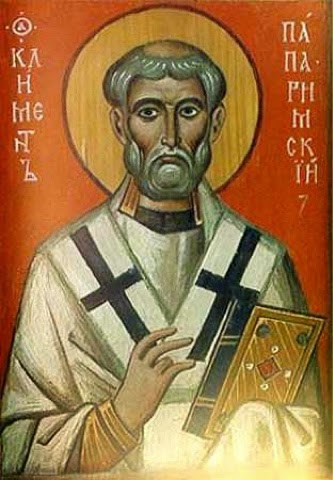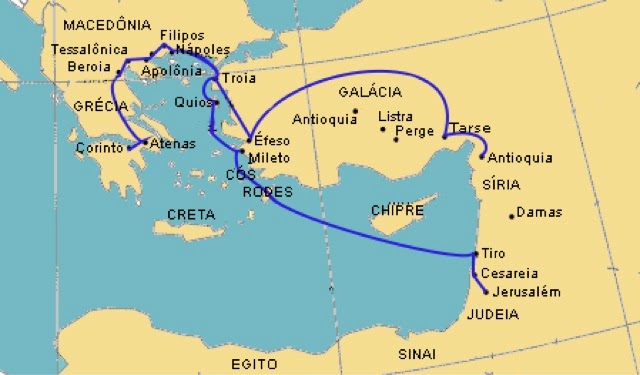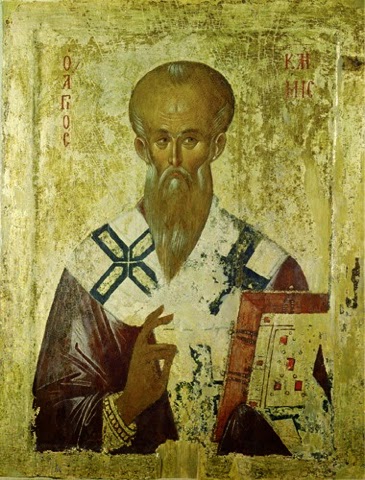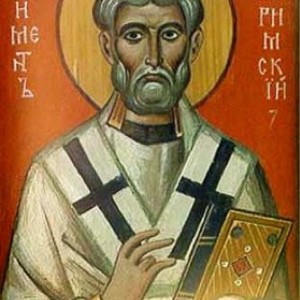For my money, one of the strongest arguments against the papacy (or at least one of the most interesting) is that the Catholic view requires us to hold that the first few popes after Peter had authority over St. John the Evangelist, even though these popes weren’t Apostles, and John was.
 |
| Pope St. Clement (Clement of Rome), Author of 1 Clement |
Answer: c. 95-96 A.D.
As the University of Exeter’s David G. Horrell explains, “Although a precise and irrefutable dating of 1 Clement is impossible, there is widespread agreement that it was written in the last decade of the first century, perhaps around 95-96 CE.”
On this issue, the modern scholarly consensus is in agreement with the testimony of the earliest Christians, who say that Clement was the third Bishop of Rome (or fourth, if you count St. Peter, who was both Apostle and bishop). Tertullian, writing around 200 A.D., describes how, unlike heretical sects, the Catholic Church has Apostolic Succession. In describing this succession, Tertullian notes that St. Clement was ordained by St. Peter, and was Bishop of Rome:
Let them exhibit the origins of their churches, let them unroll the list of their bishops, coming down from the beginning by succession in such a way that their first bishop had for his originator and predecessor one of the apostles or apostolic men; one, I mean, who continued with the apostles. For this is how the apostolic churches record their origins. The church of Smyrna, for example, reports that Polycarp was placed there by John, the church of Rome that Clement was ordained by Peter. In just the same way the other churches produced men who were appointed to the office of bishop by the apostles and so transmitted the apostolic seed to them.
But not to dwell upon ancient examples, let us come to the most recent spiritual heroes. Let us take the noble examples furnished in our own generation. Through envy and jealousy, the greatest and most righteous pillars [of the Church] have been persecuted and put to death. Let us set before our eyes the illustrious apostles. Peter, through unrighteous envy, endured not one or two, but numerous labours, and when he had finally suffered martyrdom, departed to the place of glory due to him. Owing to envy, Paul also obtained the reward of patient endurance, after being seven times thrown into captivity, compelled to flee, and stoned. After preaching both in the east and west, he gained the illustrious reputation due to his faith, having taught righteousness to the whole world, and come to the extreme limit of the west, and suffered martyrdom under the prefects. Thus was he removed from the world, and went into the holy place, having proved himself a striking example of patience.
 |
| 1Pontormo, St. John the Evangelist (1525) |
Answer: Sometime after c. 96 A.D.
During the nineteenth century, scholars dated the Gospel [of John] to the last half of the second century because of its perceived Hellenistic influence. In the twentieth century, however, two factors combined to push the likely date of composition somewhat earlier. First, the John Rylands Library Papyrus (P52), a small fragment of a papyrus codex with a few verses from John 18, was discovered in 1935 and dated variously from 117-150 C.E., indicating a date of composition no later than the end of the first century, given the time needed for the text to spread to Egypt. Second, the discovery of the Dead Sea Scrolls at Qumran in 1948 and their subsequent analysis provided additional evidence both for the complex diversity and thorough Hellenization of first-century Judaism and also for the Jewish background of Johannine motifs previously thought drawn from the gentile world, such as the light/dark duality so prominent in the prologue (1:4-5). A latest reasonable date for the Gospel’s composition, then, is before 100 C.E.
The encyclopedia goes on to argue that while establishing an earliest possible date is more difficult, the general consensus is that John’s Gospel dates to the 90s.
For when, on the tyrant’s [Domitian’s] death, he [the Apostle John] returned to Ephesus from the isle of Patmos, he went away, being invited, to the contiguous territories of the nations, here to appoint bishops, there to set in order whole Churches, there to ordain such as were marked out by the Spirit.
 |
| Map depicting St. Paul’s third missionary journey, including to Corinto (Corinth) |
The last two points are relatively non-controversial: it’s generally accepted that 1 Clement was written about 96, and that the Apostle John died about 100. So what? Well, consider how 1 Clement begins. Pope Clement, speaking on behalf of the entire Roman Church, says:
The Church of God which sojourns at Rome, to the Church of God sojourning at Corinth, to those who are called and sanctified by the will of God, through our Lord Jesus Christ: Grace to you, and peace, from Almighty God through Jesus Christ, be multiplied.
Owing, dear brethren, to the sudden and successive calamitous events which have happened to ourselves, we feel that we have been somewhat tardy in turning our attention to the points respecting which you consulted us; and especially to that shameful and detestable sedition, utterly abhorrent to the elect of God, which a few rash and self-confident persons have kindled to such a pitch of frenzy, that your venerable and illustrious name, worthy to be universally loved, has suffered grievous injury.
What does this mean?
It means that when there was schism within the Corinthian church, they appealed all the way to Rome for assistance and consultation, even though the Apostle John was alive at the time. We don’t know exactly when the Corinthians wrote, but it was early enough that Clement is apologetic for his delayed response in 96 A.D.
Apart from the pope and the Apostles, no one is afforded this kind of respect and deference in the Apostolic age. And when Clement responds, he’s not afraid to order the schismatics to return to the true Church:
Ye therefore, who laid the foundation of this sedition, submit yourselves to the presbyters, and receive correction so as to repent, bending the knees of your hearts. Learn to be subject, laying aside the proud and arrogant self-confidence of your tongue. For it is better for you that you should occupy a humble but honourable place in the flock of Christ, than that, being highly exalted, you should be cast out from the hope of His people.
So you have the Roman church intervening in a local church dispute, and issuing orders. You’ve got the Bishop of Rome speaking on behalf of the whole church of Rome. And you’ve got all this going on while the Apostle John is still alive. A standard Protestant ecclesiology would suggest that this matter would have been handled entirely at the congregational level, or barring that, by appealing to the still-living Apostle.
 |
| The other Clement: St. Clement of Alexandria |
How do the early Christians respond to this Roman intervention into the affairs of Corinth? Do they view this as a papist usurpation of John’s Apostolic authority, or as a violation of the autonomy of the local church? Nope. On the contrary, the major dispute following Clement’s letter is whether or not it should be considered Scripture.
St. Clement of Alexandria (the other Clement, mentioned earlier), after citing Scriptural passages on martyrdom, continues:
Moreover, in the Epistle to the Corinthians, the Apostle Clement also, drawing a picture of the Gnostic, says: […]
Even as late as St. Jerome’s book De Viris Illustribus (On Illustrious Men), from the late fourth century, we hear that Clement’s letter is still being read liturgically, as if it were Scripture:
He [Clement] wrote, on the part of the church of Rome, an especially valuable Letter to the church of the Corinthians, which in some places is publicly read, and which seems to me to agree in style with the epistle to the Hebrews which passes under the name of Paul but it differs from this same epistle, not only in many of its ideas, but also in respect of the order of words, and its likeness in either respect is not very great.

In my first year of graduate school I was concerned with questions of apostolic succession and episcopal authority. Thus I was immersed in scholarship on 1 Clement. Most the secondary publications I read interpreted Clement’s exercise of authority and his view of himself in relation to his fellow bishops in a way very different than modern Roman Catholics interpret the authority of the Papacy. I would be careful not to read too much into 1 Clement. Your findings offer just as much, if not more credence to the Oriental Orthodox and Eastern Orthodox views of the Bishop of Rome.
I recommend reading “1 Clement’s View of Ministerial Appointments in the Early Church” by W. Moriarty
(Vigiliae Christianae, Vol. 66, No. 2 (2012), pp. 115-138)
On the contrary, one would be hard pressed to controvert the idea that the bishop of Rome had a place of special authority in the Church prior to the Imperial adoption of Christianity and the birth of Constantinopolitan Christendom. Try reading Adrian Fortescue’s “The Early Papacy Until 451” to get an idea of how the early Church understood and interacted with Rome. I do not have my copy, but the examples are numerous in quantity and variety. Papal power did decline with the rise/creation of the archbishopric in “New Rome” and Italian politics, which I think is part of the reason why the Greeks were so taken aback when Ss Leo IX and Gregory VII began asserting authority in the 11th century.
I would also be very cautious of using a proof text method and calling Clement’s letter to Corinth or the Petrine epistles “papal encyclicals”, which are more ramblings about whatever occupies the pope’s mind than historically important precedents of power. How the early Church interacted with Rome gives us better context than merely what they wrote.
They still have apostolic succession, right?
If one gives due weight to the historical and linguistic context of 1 Clement, then they would find it difficult to agree with Fortescue’s conclusions. Fortescue is a product of his environment and reads church history as such. When the Bishop of Rome is found exercising any sort of authority in the early Church, Roman Catholics are quick to interpret such action in light of their modern understanding of the Papacy, but this is a grave error.
Why is someone always a product of their time when they hold a position that undermines ours.
As an avid Fortescue reader, I would hardly call him the “product of his time.” He called Pius X an “Italian lunatic” and a “deplorable individual”. Fortescue was something of a pioneer in that he treated the various Eastern Churches as separate churches, not as “Eastern Roman Catholics” or “Easter schismatics.” His theology was very patristic, not scholastic and he had little regard for canon law. Perhaps you should make the effort to read him.
His book on the papacy spends very little time at all on Clement’s epistles. It is mostly examples of other bishops throughout the Church writing to the pope for theological or juridical judgments on various matters from Christology to whether or not to admit certain people to Communion. Even if you walk away disagreeing, it is well worth your time to see how early Christians viewed the papacy/Roman See rather than relying on the polemics of Pollyanna Orthodox or 19th century Ultramontanists.
Right, because Papal criticism was unheard of at the time of Fortescue /sarcasm. Like Dante and Fortescue after him, one can support the office of the Papacy while being critical of specific popes.
Just because I disagree with your interpretations of Fortescue and the patristics does not mean I haven’t read them. Given my thesis topic, I am immersed in them every day. It is foolish and a bit condescending to accuse those who hold the Orthodox opinion on Rome’s authority to be “relying on the polemics of Pollyanna Orthodox or 19th century Ultramontanists,” especially since some of the best historians of Christianity are among those that hold such an opinion (Pelikan, Chadwick, Kelly).
Pelikan, Chadwick, Kelly: all Protestants. Talk about “products of their environment.”
What *is* the Orthodox position on the authority of Rome? I’ve encountered everything from Rome’s claims are tantamount to being a precursor of Anti-christ to the other extreme where they would advocate for Sardica canon 3 and the Formula of Hormisdas.
@Daniel, What *is* the Catholic position on the Orthodox? What exactly are “Sister Churches” that are in “imperfect communion”? What exactly does that mean?
Sorry I replied in the wrong spot. Derp derp derp.
Seraphim:
What I meant is that the Orthodox tend to reread history through the lens of the theology that they have created since the schism, such as the idea that the Bishop of Rome is, or was, an honorary first among equals when he was never any such thing (a converse of what the Ultramontanes does when they read Vatican I backwards). Indeed, prior to the schism, the church of Constantinople considered him no such thing. Florence spent 8 months talking about the filioque clause in the Latin Creed and 4 months on Purgatory. They spent less than 2 weeks discussing the pope’s authority. I recall a quote from one 11th century Greek saint in Geoffrey Hull’s book that went something like “We would gladly have the pope, but will he be our father or our over lord?”
At the time of Fortescue, criticism of the popes was very rare. George Tyrrell was denied last rites for basically that. Cardinal Newman was considered a liberal and alienated by his former friend, Cardinal Manning. HIstory has vindicated Newman and Fortescue, but Dr F’s sarcasm was indeed quite risky at the time.
Joe,
I would say your argument is sound: That Clement was acting authoritatively from Rome even though John was (likely) still alive and much closer to Corinth.
That said, I would say that one detail isn’t established: That Revelation was written in AD96. The Early testimonies are clear that John was still alive at that date, thus leaving your argument in tact, but the writing of Revelation actually happened much earlier, around AD65.
There is good reason to believe this, especially since the Dating of Revelation is largely based on confusing Irenaeus’ claim that John was still alive with that being the time John wrote Revelation, when in fact those are two different things. By AD96, John did end up seeing what his vision long before had foretold. Here’s a brief article on the matter:
http://catholicnick.blogspot.com/2012/05/importance-of-70ad-for-christianity-was.html
Nick,
You make a good argument in your post, but I’m still inclined towards the later date, for the reasons given here.
Either way, as you note, both sides agree that the Apostle John was active in the Church until his death c. 100.
I.X.,
Joe
Regarding the date of 1 Clement, please see Thomas Herron, Clement and the Early Church of Rome: On the Dating of Clement’s First Epistle to the Corinthians.
As to the above.
http://www.emmausroad.org/Clement-and-the-Early-Church-of-Rome-On-the-Dating-of-Clements-First-Epistle-to-the-Corinthians-FONT-colorff0000beBookbFONT-P11725.aspx
DMW,
My position is that of the Melkite Bishop Nicholas Samra:
Several events in recent history contributed to the Churches revisiting the question of Church unity. The twentieth century Russian Orthodox theologian, Fr. Georges Florovsky, was the first to propose a new middle ground. “It is impossible to state or discern the true limits of the Church simply by canonical signs or marks,” he wrote. “In her sacramental, mysterious existence the Church surpasses canonical measurements. For that reason a canonical cleavage does not immediately signify mystical impoverishment and desolation. All that Saint Cyprian said about the unity of the Church and the sacraments can be and must be accepted. But it is not necessary, as he did, to draw the final boundary around the body of the Church by canonical points alone.”
Vatican II marked a new appreciation of other Christians. In their discussion of the Church the council fathers employed a new term to restate the Augustinian position: “The one Church of Christ … subsists in the Catholic Church, which is governed by the successor of Peter and by the Bishops in communion with him, although many elements of sanctification and of truth are found outside of its visible structure. These elements, as gifts belonging to the Church of Christ, are forces impelling toward catholic unity. (Lumen Gentium, 1: 12, 13). To “subsist” means to “be,” to “have existence” and so the fathers taught that the Catholic Church is where the one Church of Christ is to be found. Yet, they said, many elements of sanctification and truth” are found outside it.
The chief ecumenical experience of the bishops at Vatican II was with the various Protestant denominations. Clearly the above statement refers to that context. Most Protestants, for example, have baptism. Not all, however, baptize in the name of the Father and of the Son and of the Holy Spirit. All Protestants have marriage but not many consider marriage a sacrament.
When formal dialogs began with the Eastern and Oriental Orthodox Churches, that explanation proved inadequate. The International Orthodox-Catholic Theological Dialogue issued this statement instead: “Catholics and Orthodox once again consider each other in their relationship to the mystery of the Church and discover each other once again as Sister Churches. …On each side it is recognized that what Christ has entrusted to his Church – profession of apostolic faith, participation in the same sacraments, above all the one priesthood celebrating the one sacrifice of Christ, the apostolic succession of bishops – cannot be considered the exclusive property of one of our Churches.
“It is in this perspective that the Catholic Churches and the Orthodox Churches recognize each other as Sister Churches, responsible together for maintaining the Church of God in fidelity to the divine purpose, most especially in what concerns unity” (Balamand 12-14).
Thus the mystery of the Church “subsists” in each of the historic, apostolic Churches in relationship to one another in a communion of love. While some “elements or sanctification and truth” are found in Protestant denominations, the mystery of the Church subsists fully in the Orthodox and Catholic Churches.
https://melkite.org/faith/sunday-scriptures/being-in-the-one-body
And then it’s a corollary that our communion is imperfect. There is administrative schism, one-sided invitations of Eucharistic communion, and lots of suspicion on both sides that The Other is in heresy.
I am impressed with the level of thought in these comments. This high caliber of research and logic is even more shining given the comments of the latest post on Pope Francis. I really appreciate Seraphim’s comments and research.
It is good to see you give a later date to Revelation. One recent theory (at least it was new to me) states that the Book of Revelation is actually a Jewish (apocalyptic) book. Chapters 1-3 and 22 were added to the Jewish book to make them Christian. This theory states that if you take out these chapters, then the book reads as one smooth apocalyptic book of Jewish origin. It is an interesting idea. Peace!
But it does mention the lamb, right?
Your icon for Clement of Alexandria is actually St. Clement of Ohrid. Note, too, that most icons of Clement on the web are St. Clement of Ancyra. There are no icons of Clement of Alexandria, since he is not venerated by the Orthodox Church as a saint; nor was he ever a bishop (note the omophorion).
This was a relatively recent discover for me. Do you know the main reason why he’s not venerated?
One thing that’s probably worth saying about 1 Clement is that it doesn’t prove everything the Catholic Church says about the Papacy. It is, however, consistent with it. If you’re a Catholic and read 1 Clement, it makes sense. More than anything else, it requires an explanation from others as to why the Bishop of Rome is meddling in the affairs of another congregation so far away.
Read “1 Clement’s View of Ministerial Appointments in the Early Church” by W. Moriarty
(Vigiliae Christianae, Vol. 66, No. 2 (2012), pp. 115-138).
It is one of the most extensive studies on what the author of 1 Clement intended in writing his letter. The author concludes that the author isn’t “meddling in the affairs of another congregation so far away,” but rather counseling as one brother to another.
Also, some have argued that Corinth was within the Patriarchate of Rome. See this map, for instance:
http://www.brycerich.net/images/stories/partriarchs-map.jpg
Isaac,
You seem to suggest two different theories which don’t harmonize with one another: first, that Clement was acting in a merely-fraternal way, as if Rome and Corinth were equals; and second, that Clement was acting as a patriarch to settle a dispute within his own patriarchate. Am I right in characterizing your positions in this way? (In saying “your positions,” I don’t mean that you’re necessarily endorsing them, but that you seem to treat them as plausible).
There are certainly elements of truth to both theories. There is an element of fraternity between Peter and the Apostles, as between the pope and the bishops, and between Rome and the other churches. This fraternity doesn’t deny the spiritual authority entrusted to Peter and his successors, of course.
Likewise, in exercising that authority, there’s no doubt that the pope has a much more active interest in those affairs in which he is most enmeshed. So the pope is more active in the goings-on in Rome than, say, Paris; more active in the affairs of the Latin Rite than the Eastern Rites, etc. And in the days of the pentarchy, this was formalized in a very particular way. All of this is very much in keeping with the Catholic principle of subsidiarity, as with human reasoning.
Nevertheless, despite elements of truth, neither theory is fully tenable. To the first theory: if this were merely-fraternal interactions without any sense of a hierarchical superior, it’s quite odd that (a) Corinth specifically wrote to Rome for help; (b) Corinth didn’t write to the Apostle John, who was certainly a superior; and (c) we never see Corinth (or any other church) intervening in the internal affairs of Rome. As far as I’m aware, these “fraternal interventions” only ever run one way for all of history. Which makes this look like something quite other than bidirectional fraternal interventions.
To the second theory: the pentarchy doesn’t exist at this point, so it’s anachronistic. Also, if these interventions are just based upon geography, Rome is about three times further away from Corinth than is the island of Patmos. Patmos and Corinth, after all, are both in modern-day Greece. So neither of these theories actually explains the evidence in a wholly-satisfactory way, even if both have traces of truth.
I.X.,
Joe